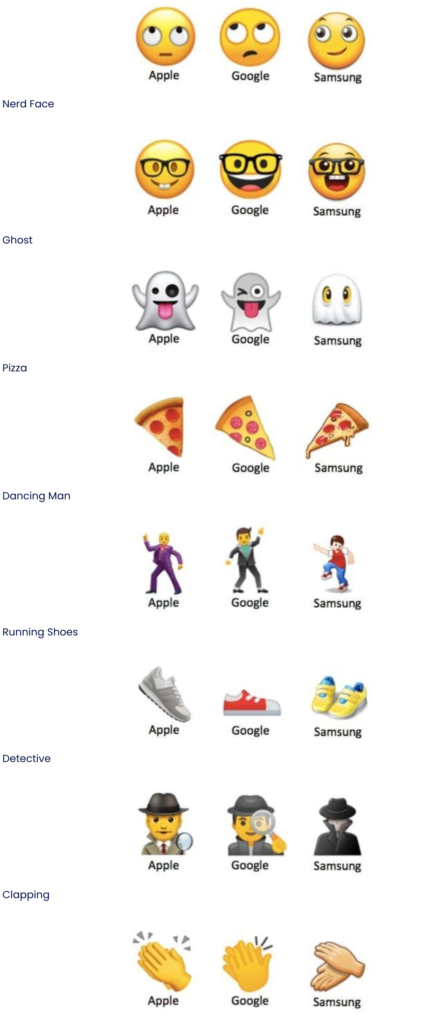Emojis are common in online or digital communication. However, there are delivered differently on different platforms like, for example, Android and iOS. It is unidentified how many of you are aware that emoji have many renderings or whether they would alter their emoji bearing texts or messages when they could perceive how these messages deliver on receivers devices.
What Is Exactly an Emoji?
As a whole, emojis are graphical images, which reflect a specific facial expression or appearance. They are made with the application of a drawing instrument. They are integrated into an exceptional 16-bit Unicode to make them well-matched with OSs (operating systems) of the most popular platforms and devices such as Windows, macOS, Android, and iOS.
What is more, being just a picture or image, emojis are animated as well to exaggerate the emotions of the message by the sender. You can find many good examples like animations while utilizing Skype messenger.
The reason behind these emojis’ popularity is that the emoticon is the close likeness of the former to real-like expressions, which they reflect once delivered to a receiver. So, it is safe to say that one emoji can be worth many sentences while texting once used in the right way.
Why do Emojis look on Multiple Platforms?
As many people of all ages, tools, and devices, as well as technology-savvy, adopt emojis in online messages and texts, we should address an issue some seem to understand. Emojis look differently on diverse platforms. The standard programming language or Unicode that enables the communication between platforms is relatively much fail-safe for text. Words are words. There is no cross-platform kink to work out. However, with regards to emoji characters, things become trickier. Due to the licensing concerns, a lot of messaging technologies on diverse platforms should make their understandings of the corresponding symbols. Therefore, an emoji on iOS might look different on Windows or Android platforms. And let us say the outcomes differ.
Emojis Look Differently on Various Platforms
So can emoji be used on multiple platforms? The answer is yes, but they appear differently. Emojis are a remarkable addition to the communication toolbox. Without saying anything, you can talk about places, people, emotions, and things. However, diverse platforms sometimes show the same emoji specification in various ways.
Like for instance, an eye roll may come across as cheerful or petulant. A snake may look adorable or threatening. To assists you navigate some confusing cross-platform interactions, here are the emojis that appear with significant differences on various platforms such as Apple (iOS 11.1), Google (Android 8), as well as Samsung (Galaxy S8).

How to Solve Cross-Platform Emoji Issue
As good as they appear on some platforms, not all can see emojis likewise. Unicode announces a standard to make sure that characters are defined strictly and are well-matched in any platform, which utilizes Unicode. They are not accountable for the emojis design.
Like for example, if Windows and iOS power your desktop, you will see that emojis don’t look identical on these two devices. You are able to spot the disparities once you go to the website Emojipedia. The distinctions for characters like Sparkles might not be puzzling; however, for emojis smiling face with rolling eyes, there are many interesting interpretations in platforms.
Given the development and progress of the Android emoji from white and black to front and side views, the disparities in these characters can alter the explanation of the signs and symbols. A good example is the flushed face character. On iOS, it appears like a shock expression and embarrassment. On the other hand, on Android platforms, it could entail a “naw-shucks flushed face.” If you’re sending that character from an outdated Android device to a friend using an iOS device, they won’t spot the “naww” which you see and, as a result, might signify the character very differently. Without any control over the visuals, which are utilized for the emojis, the possibility of miscommunication is high.
Research conducted by the University of Minnesota reveals that this problem isn’t just a cross-platform but an inter-platform as well. Since this research, one of the emojis specifically mentions, a grinning face with a smiling eye has been enhanced on various platforms so that it noticeably diverse from Grimacing face.
Above all, being capable of seeing the small disparities in details isn’t something all users can do. It depends on what you are using, a web or phone, and the screen size; emoji can be very small and hard to see. Enabling some kind of mechanisms, so users are able to spot the name of the character is excellent for accessibility and usability.
Like for instance, the web interface of GitHub carries this out by means of showing emoji shortcodes when users hover or flit around their mouse over the characters or emojis. On the other hand, GitHub typically depends on the native technology implementation of the character. Twitters’ interface takes this a step further by replacing the emoji with an embedded picture, complete with comprehensive descriptive text on the title feature of the image tag. What is more, Twitter makes use of the Alt feature to keep the original character; therefore, when you choose the block of text and copy it to the clipboard, the character is copied. This is a feature of WYSIWYG HTML Editor that is a remarkable feature given inline pictures.
Sad to say, this whole full-type web accessibly offered by this platform isn’t on hand as open source. Twitter does offer twemoji which an emoji replacement script that handles the character to picture replacement, however not the definitive text. For a client-side script to carry this out, it would need to have local knowledge of all characters’ descriptions, which is many megabytes of data.
So what is the best solution for this? Keep on Reading!
Emojificiate is a proof of concept, a server-side implementation of totally web-accessible emoji. It sources its data from the unicodedata module that is amassed directly from the Unicode Standard. The version utilized relies on which Python version is utilized. The latest Python version, the latest Unicode version, the more characters or emoji can be determined and recognized.
The script’s place to allow more efficient communication of the characters themselves, it is on users of characters or emoji to make sure that the readers of the communication do not wrongly assume the meaning. By limiting the prospective for miscommunication, emoji is able to add spark to text communication with no need of taking meaning away.
